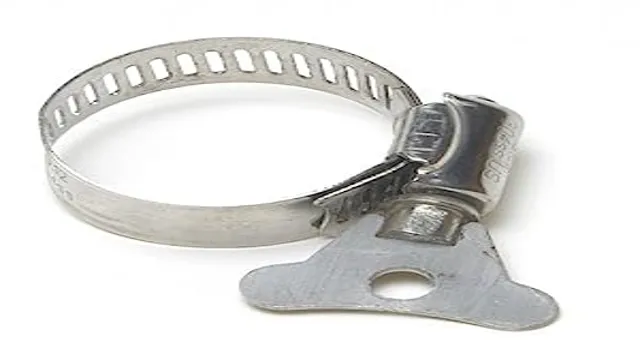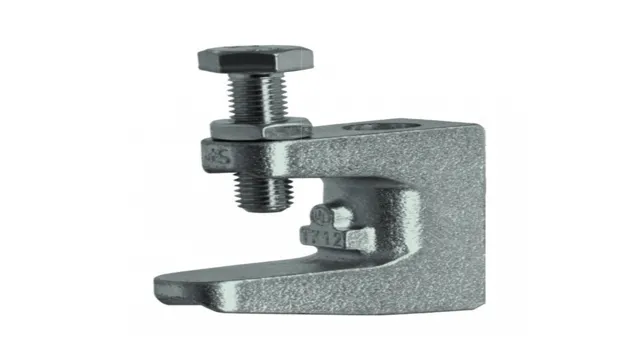Can You Over Tighten Hose Clamps? Avoiding Damage and Leaks

Hose clamps are an essential part of any plumbing system. They provide a secure connection between two hoses, preventing leaks and ensuring that the system operates efficiently. However, it is essential to understand that there is such a thing as over-tightening hose clamps.
Over-tightening a hose clamp may seem like a good idea at the time, but it can lead to potential risks that can cause damage to the hoses or the overall plumbing system. So, can hose clamps be over-tightened? Yes, they can. If you tighten a hose clamp too much, it can damage the hose, resulting in leaks or even burst hoses.
Over-tightening can also cause the clamp to become loose over time, which can lead to leaks that can damage the surrounding area or the entire plumbing system. In essence, hose clamps are like a handshake between two hoses – you want the handshake to be firm, but not too tight. It is essential to understand that hose clamps have a specific level of tightness, recommended by manufacturers, which should not be exceeded, as it can cause more harm than good.
Excessively tight hose clamps compress the hose material and decrease the overall life of the hose. That said, before you tighten your hose clamp, make sure to check the manufacturer’s recommendation, as well as follow the appropriate torque specifications. Remember to use enough force to achieve a secure and leak-proof connection, but do not over-tighten, as doing so can lead to significant risks and damages.
What is a Hose Clamp?
Hose clamps are a critical component of any liquid or gas distribution system, as they keep hoses securely attached to pipes or other fixtures. When it comes to tightening hose clamps, it’s important to be mindful of how much force you’re applying. Over-tightening can actually cause the hose to become damaged or even rupture, which can result in leaks or other complications.
In order to avoid this, it’s important to follow the manufacturer’s instructions and use the appropriate tools for your specific hose clamps. By taking the time to properly tighten your hose clamps and avoid over-tightening, you’ll be ensuring that your system operates safely and efficiently, without any unexpected interruptions or damage. So yes, you can over tighten hose clamps, so be careful and follow any guidelines provided!
Definition and Function of Hose Clamps
A hose clamp is a device typically used in the plumbing and automotive industries to secure hoses onto fittings. Its function is to prevent leaks and maintain the pressure of fluids or gases flowing through hoses. These clamps come in various sizes, shapes, and materials, each suited for the type of hose and application.
For example, screw clamps are suitable for low-pressure applications, while spring clamps provide better grip and are appropriate for high-pressure systems. Hose clamps are an essential component in systems that use hoses to transport fluids and gases, and they play a vital role in preventing hazards such as gas leaks and fires. A hose clamp is an essential tool for anyone who needs to secure hoses to fittings, and its durability and quality are essential in maintaining the safety and reliability of the system.

What Happens When Hose Clamps Are Over Tightened?
Yes, you can definitely over tighten hose clamps and it can cause a range of issues including leaks and even damage to the hose or fitting. Over tightening can cause the clamp to compress too tightly, which leads to distortion of the hose. This can make it more difficult to seal the connection and may even result in the hose pulling away from the fitting.
In addition, over tightened clamps can also cause cracks to form in the hose or fitting, which can lead to leaks or even complete failure over time. It’s important to use proper torque settings when tightening hose clamps to ensure a secure connection without distorting or damaging the hose. Avoid over tightening or using excessive force to prevent these issues and ensure the longevity of your hoses and fittings.
Damage to Clamps
Over tightenting of hose clamps can cause them to become damaged over time. The clamp can deform and the rubber tube can become distorted or even punctured, leading to leaks or even system failures. This is because the clamp exerts too much pressure on the hose, which eventually causes it to become weakened and worn out.
It is important to tighten the clamps appropriately, while making sure there is enough pressure to hold the hose securely in place without causing any damage. If you suspect that your hose clamps have become damaged due to over tightening, it is best to replace them as soon as possible to prevent any further issues. Remember to always follow the manufacturer’s recommended torque settings for proper installation and maintenance to keep your system running smoothly and efficiently.
Damage to Hose
Over tightening hose clamps can be incredibly damaging to your hoses. When clamps are over tightened, they can put excessive pressure on the hose, which can lead to a variety of issues such as bulging or bursting. This pressure can also cause cracks in the hose, leading to leaks and ultimately, failure.
Additionally, over tightening can cause damage to the clamp itself, making it more likely to fail in the future. It’s important to ensure that your hose clamps are tightened to the appropriate torque specification to avoid any unnecessary damage. Remember, a little extra pressure is not worth the potential damage it can cause.
Proper installation means a longer life for your hoses and clamps.
Leakage and Other Risks
Over-tightening hose clamps can lead to multiple risks, including leakage, damage to the hose or clamp, and overall system failure. Over-tightening a clamp can cause it to deform, resulting in a loose fit, which can cause leaks. On the other hand, over-tightening can cause the clamp to dig into the hose, which can harm the hose and cause more significant leaks.
Additionally, over-tightening can lead to rapid aging and cracking of the hose. In some cases, it can even cause the hose to burst, potentially damaging not only the system but also causing harm to nearby individuals. Therefore, it’s crucial to be mindful when tightening hose clamps and ensure that you don’t go overboard.
Remember, it’s always better to tighten gradually and check for leaks rather than rushing the process and risking damage to your system and potential harm to others.
How to Avoid Over Tightening Hose Clamps
Can you over tighten hose clamps? Absolutely! Over tightening hose clamps can lead to a multitude of issues, including damaging the hose, causing leaks, and even cracking the fitting. It’s important to remember that hose clamps are designed to create a secure seal, but not to crush the hose itself. To avoid over tightening, ensure that you are using the correct size and type of clamp for the hose, and make sure to follow the manufacturer’s recommended torque specifications.
Use a torque wrench to ensure that the clamp is tightened properly, and give a gentle tug on the hose to confirm that it is secure. Remember, a snug clamp is ideal; you don’t need to crank it down as hard as you can. By taking these simple precautions, you can avoid damaging your hoses and ensure they perform correctly.
Choosing the Right Clamps
Choosing the right clamps for your plumbing or automotive applications is crucial to ensure a secure and leak-proof connection. But over-tightening hose clamps can cause more harm than good, leading to damage or failure of the clamped parts. So, how can you avoid over-tightening hose clamps? Firstly, make sure to use the right type and size of clamp for the job.
Worn or damaged clamps should be replaced immediately to prevent leaks. Secondly, tighten the clamp only till it’s snug, not overly tight. A good rule of thumb is to use a torque wrench for a precise and consistent tightening force.
Lastly, check the clamp regularly for any signs of leakage or loosening and make necessary adjustments. By following these simple tips, you can achieve a perfect balance between clamp tightness and security without risking any damage or failure.
Using Proper Tightening Techniques
As a homeowner, you may have encountered the frustration of a leaky hose connection. Often, the culprit is not the hose itself but the hose clamp that secures it in place. However, over-tightening the clamp can cause damage to both the hose and the fitting.
So, how do you ensure that your hose clamp is tightened just enough without causing damage? Firstly, avoid using pliers or wrenches as they can apply too much force. Instead, use a screwdriver to tighten the clamp until it is snug, and then give it a quarter turn more. Secondly, ensure that the hose clamp is positioned correctly, directly over the raised area of the fitting.
Lastly, always check the tightness of your hose clamps after the first hour of use. By following these simple guidelines, you can avoid over-tightening hose clamps and prolong the life of your hoses.
Conclusion: The Importance of Proper Hose Clamp Tightening
In conclusion, while it may seem like a good idea to tighten hose clamps as much as possible to prevent leaks, over-tightening can actually cause more harm than good. Just like in life, finding the right balance is key. So go ahead and tighten those clamps, but don’t go too tight or you might end up with a busted hose and a messy situation on your hands.
Remember, there’s a fine line between holding things together and breaking them apart!”
FAQs
How much torque should be applied to hose clamps?
It is recommended to use a torque wrench and tighten the hose clamp to the manufacturer’s specifications to avoid over-tightening.
Can over-tightening hose clamps cause damage?
Yes, over-tightening hose clamps can damage the hose, the connection point, or even the clamp itself, leading to leaks or other issues.
What are some signs of over-tightened hose clamps?
Signs of over-tightened hose clamps include deformation of the clamp or surrounding parts, cracks or damage to the hose, or difficulty removing the clamp.
How do you remove an over-tightened hose clamp?
To remove an over-tightened hose clamp, try using pliers or a clamp removal tool. If the clamp is still stuck, try gently heating the surrounding area with a heat gun to expand the metal.
What is the proper way to tighten a hose clamp?
The proper way to tighten a hose clamp is to use a torque wrench or a clamp tightening tool to achieve the recommended torque specifications.
Can reusing an over-tightened hose clamp cause issues?
Yes, reusing an over-tightened hose clamp can weaken the metal and cause it to break or fail under pressure.
How often should hose clamps be checked for proper tightness?
Hose clamps should be checked periodically and tightened if necessary. How often depends on the specific application, but is typically recommended for every oil change or annual maintenance check.



